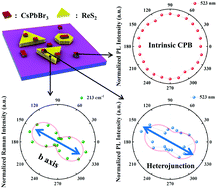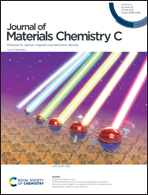Spread of in-plane anisotropy in CsPbBr3/ReS2 heterostructures by proximity effect†
Abstract
In-plane anisotropy (IPA) refers to in-plane angle-dependent properties defined by asymmetric structure, which renders an additional control for precise modulation of properties. In contrast, most known materials are of isotropic structure without obvious IPA. Thus, the introduction of anisotropy into isotropic materials, integrating the merits of both, is becoming an interesting and worthwhile area of study. Herein, we demonstrate experimentally the spread of IPA from anisotropic ReS2 to isotropic cubic CsPbBr3 (CPB) based on epitaxially grown CPB/ReS2 heterostructures. Angle-resolved photoluminescence (PL) spectra reveal that the PL pattern of the CPB single crystal evolves from an individual isotropic round shape into an anisotropic dumb-bell shape, with its polar axis oriented along the b-axis of ReS2 beneath CPB in heterostructures, indicating a significant substrate-induced optical isotropy–anisotropy transition. This study verifies the feasibility of spreading IPA with proximity effects in ultrathin heterostructures, extending the applications of intrinsic isotropic two-dimensional materials in angle-dependent fields.



 Please wait while we load your content...
Please wait while we load your content...